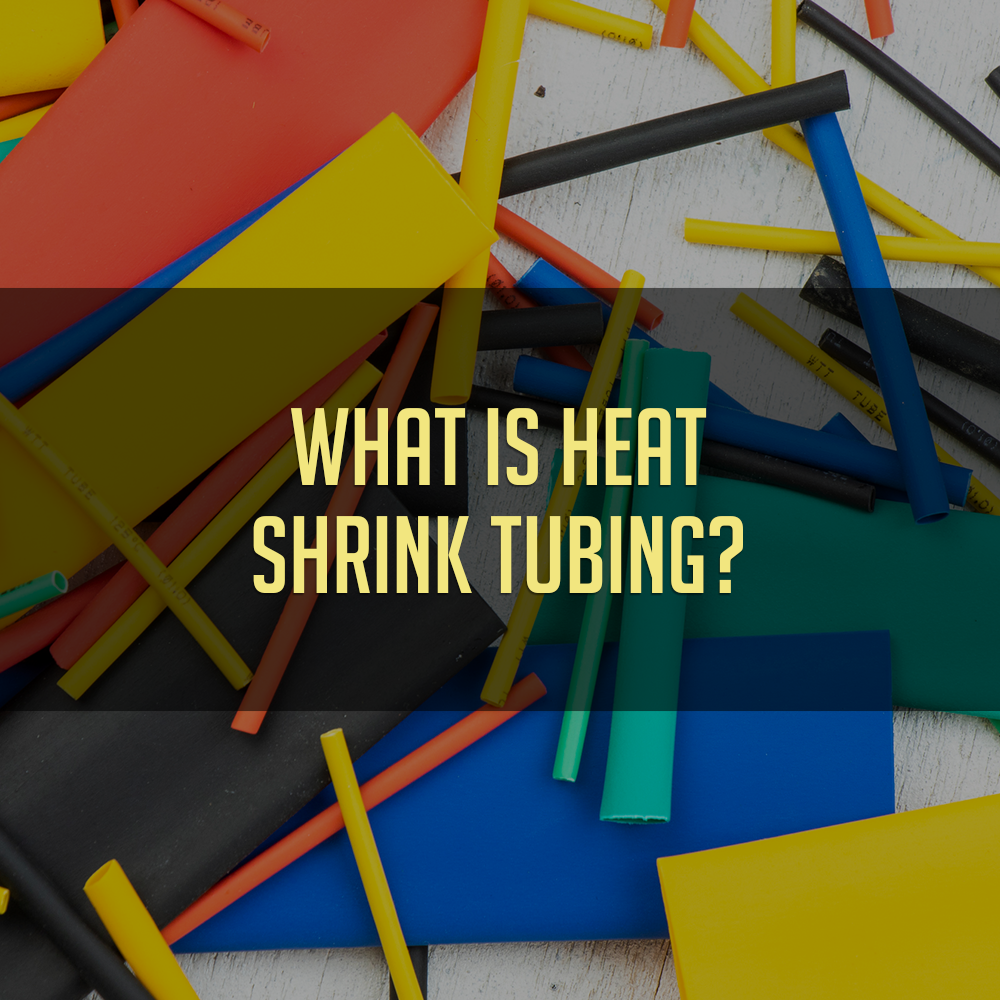What is heat shrink tubing?

Description and general purpose
The term “heat shrink tubing” might seem to be pretty self-explanatory: It’s tubing that shrinks when you apply heat to it. But if you’re not familiar with the product at all, your response to that would probably be, “Okay, so then what?”
To truly define heat shrink tubing, we need to look at what it’s used for, which happens to be a lot of things across multiple industries. A major use is for insulating or protecting wiring. It can also be used to secure connections between two wires or cables.
If you’ve got a lot of wires or cables running through an area, heat shrink tubing can have the additional benefit of avoiding tangling and helping to identify them. Finally, it can insulate against shocks or short-circuits in the wiring. Heat shrink tubing is classified by three things: the material it’s made of, whether it’s single- or double-walled, and its shrink ratio.
Single-walled and double-walled are exactly what they sound like. The former contains one layer of the same material. The second type has an inner layer that melts when the outer layer shrinks, binding that layer to whatever you’re wrapping. You’ll often hear this referred to as the “adhesive layer.”
The shrink ratio simply tells you how much the tubing can contract when heated. You’ll see it expressed as a simple ratio, where 2:1 means it can shrink down to one half of its original diameter; 6:1 would mean it can shrink to one sixth. So a 12mm 2:1 tube could shrink down to 6mm, while a 12mm 6:1 tubs could shrink down to 2mm. Some materials will not shrink longitudinally — that is, along their length — but others will, which is always something to take into consideration for your project. In case you’re wondering, this property is achieved during manufacture. The tubing is originally extruded at its minimum diameter, then the molecules are cross-linked, which creates a structural memory of this size.
Next, the tubing is heated to its crystalline melting point and expanded, usually by being exposed to a vacuum. It’s finally rapidly cooled, which leaves it at the larger size until heat activates the “memory” of its original size and the magic happens.
Types of material
You can find heat shrink tubing in a variety of materials, ranging from common and fairly inexpensive to rare and costly. Here are the four most common types.
Polyolefin
This is a family of polymers, which are plastics made up of chains of very large molecules, each with repeating subunits. Polymers can be natural or synthetic, and they have a wide range of different properties, as can be seen in these natural polymers: shellac, amber, wool, silk, and rubber.
The properties of polyolefin vary depending on how well a particular composition forms crystals in its structure, so that they can be used for a wide array of things: Liquid lubricants, moldable foam for things like seat cushions, tennis racket strings, food containers, and even fiber used in fabrics.
When heated, polyolefin shrinks across its diameter but not along its length, anywhere from one half to one sixth of its original diameter. It is not UV resistant, so is probably best for applications that won’t be exposed to direct sunlight.
Fabric
This type of heat shrink tubing is exactly what it sounds like, and is formed from woven fabric made from polyolefin and polyester. This makes it extremely flexible but still very strong. The fabric also protects the wires inside from abrasion.
It has a lower shrink temperature than other materials, and also shrinks the most along its length, which can be a consideration in measuring properly.
Polyvinyl chloride (PVC)
You probably know this material from those white pipes you see in hardware stores and which took over for copper and iron in plumbing and piping a long time ago. It’s the third most-widely produced synthetic plastic polymer in the world. Like polyolefin, it has a wide range of uses, including bottles, packaging, imitation leather, flooring, inflatables, and canvas.
It’s cheaper than other types of heat shrink. Its combination of inertness and resistance to UV light make it ideal for food and beverage usage, as well as exposed or exterior placement. One of its drawbacks, though, is its heat sensitivity. It shrinks at 212°F (100°C) and only has an operating temperature range of -67°F to 221°F (-55°C to 105°C).
Polytetrafluoroethylene (PTFE)
You may have heard of this material by its brand name, Teflon, under which it’s famous for being used to coat non-stick cookware. In fact, it is one of the most frictionless solids known, and also repels water. Able to operate at temperatures up to 482°F (250°C), it is most frequently used for insulating wiring in computer and aerospace applications.
Unfortunately, due to its high heat tolerance, its shrink temperature is 644°F (340°C), which makes it impractical for the average DIY user. But if you need heat shrink tubing for use in a high-temperature application, then this is the right option.
Among all the types of heat shrink tubing, some of them have special properties for specific applications. For example, in addition to types that withstand high temperatures, there are also versions that are resistant to diesel, or waterproof, or shield your wires and cables from electromagnetic interference (EMI), also known as radio-frequency interference (RFI).
Useful in many industries
Because of the wide range of options in properties, heat shrink tubing is used in a number of different industries. For aerospace and military applications, heat- and chemical-resistant types are ideal, as are EMI/RFI blocking.
You can also find heat shrink tubing throughout cars, motorcycles, boats and other marine craft, and large industrial machines, where it protects and bundles wires, as well as guides them from one component to another. If you’re the kind who likes to do their own car or motorcycle repair, you should definitely have a supply of heat shrink tubing on hand.
You can find a lot of uses for your home, office, or home office as well. It’s particularly useful for keeping cables out of the way and untangled, as well as easily identifying which one plugs into which device.
Finally, one use that may not seem obvious is for large events — concerts, stage shows, festivals, seminars, and film shoots, for example. Basically, anywhere you’re going to have a lot of audio, video, and other complicated equipment wired up to be controlled from a relatively small section of the venue, you’re going to need plenty of heat shrink tubing to keep the cables together, untangled, out of the way of feet that might trip over them, and most importantly, clearly identified.
Endless possibilities
Of course, there are a lot of “off-label” uses for heat shrink tubing as well — for example, you can make a dog leash using fabric heat shrink tubing and rope. You could also use it to add rubber grips to cooking utensils or hand tools, as well as to color-code the latter, e.g. so you could tell at a glance which one is the Phillips screwdriver and which one is slotted.
Your imagination is really the only limit, and now you know enough about heat shrink tubing to start thinking about your next project.














